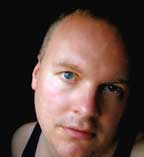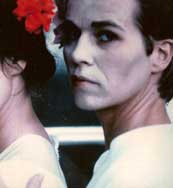|
My mother recently reminded me about the time I came home from elementary school holding a prescription for eyeglasses. She didn't believe that I had poor eyesight. Instead, she thought I had somehow faked the eye exam so I could wear glasses like my best friend, Heidi Higgins. Cruel as I felt her accusations were at the time, I am now able to laugh in retrospect. I did want to be like Heidi Higgins and not just because she wore glasses. Heidi had a wooden leg from the knee down. She ran super fast, rode horses, and swam in the river without apparently ever giving this unusual appendage a thought. She seemed so comfortable in her body. I wanted what she had.
Fantasies of how perfect everything would be if only … are the subject of a collection of essays entitled "Identity Envy." Written by lesbian and gay writers, the essays describe the detailed and elaborate fantasies the authors developed to cope with a world that was sometimes hostile, sometimes indifferent, and always lacked others with whom to easily identify. The collection is a testament to the power of imagination as a tool for psychological discovery. It is also at times funny, poignant, and compelling in its originality.
In "Tales of a Male Lesbian," Andrew Ramer claims that, unlike like his other gay friends, his inner female is not Marilyn Monroe . His inner feminine is Joan of Arc. His favorite authors are Sarton, Austen, Woolf, Stein and Collette. In many ways he prefers the company of lesbians to other gay men. "I'm good with power tools and I like cats." And he likes men. He wonders what kind of lesbian he is.
While two other essays stood out in particular for me, the entire collection is worthy of an attentive read. The stories will resonate differently with every reader but everyone can relate to the notion of wanting to be someone else – at least, or perhaps especially, during the tumultuous years of adolescence. Gerard Wozeck and Renate Stendhal both describe their adolescent explorations into self and other in their delightful essays.
In "Chasing the Grasshopper," Gerard Wozeck writes about wanting to be Kwai Chang Caine, better known as the 1970s "Kung Fu" television character Grasshopper. Played by David Carradine, Grasshopper was a martial arts adept who walked the world practicing nonviolence unless provoked to display his graceful version of violence.  Wozeck wanted the soft-spoken wisdom, the hidden physical prowess, and the all-male spiritual community. He was sure of the hot eroticism that lurked in the austerity. Wozeck wanted the soft-spoken wisdom, the hidden physical prowess, and the all-male spiritual community. He was sure of the hot eroticism that lurked in the austerity.
He settled on this elaborate fantasy after others ultimately proved unsatisfying. He abandoned thoughts of guest starring on "The Monkees" and combing Davy Jones' hair or having a high-school romance with Greg on the "Brady Bunch." Like many female and male teens in the 1970s, his pantheon of fantasy friends included David Cassidy, John Travolta, and John Denver. These shallow acquaintances were swept aside when Grasshopper appeared in "Kung Fu's" first season.
Abundant fantasies involving intricate plot lines filled Wozeck's mind as, time after time, he and Caine entered into deep abiding bonds in the face of various manifestations of the evil world. Approaching the greatest philosophical clarity by kissing Caine became his obsession. Fantasy morphed into real action when the fifteen-year-old Wozeck shaved his head, doused himself in his father's Hai Karate aftershave and, wearing his bathrobe backward, he sat in his backyard tent awaiting the mystical arrival of the beloved.
Though the long-awaited Grasshopper never arrived, some degree of wisdom and self-knowledge did. Identification with the quiet power of an Eastern ascetic enabled Wozeck to begin developing on his own reservoir of serenity. As a young gay man with no positive role models and few feelings of acceptance, his attachment to the ideals of Eastern philosophy allowed him to first acknowledge an often hostile world and, second, to learn to accept himself as a member of the real world.
But first he had to ditch the robe and let his hair grow in.
At the ripe age of fourteen, growing up in insanely sanitized post-World War Two Germany, Renate Stendhal discovered her place in the world. In "Thieves, Pimps, and Holy Prostitutes – My World," Stendhal gracefully describes how, as an adolescent, Jean Genet's "Notre Dame des Fleurs" gave her hope for something other than a dutiful, denial-steeped future. Through Genet, she discovered both passion and homosexuality. Her 'sexual awakening would be that of a boy.'
The book inspired complex feelings of longing for the violently romantic elicit love between men along with political and philosophical thoughts about power and equality.  As a budding intellectual, artist, and lesbian, Stendhal secretly stalked the streets of Hamburg seeking her people. She studied young gay men—their looks, their dress, their mannerisms, and the ways in which they were treated by the uninitiated. As a budding intellectual, artist, and lesbian, Stendhal secretly stalked the streets of Hamburg seeking her people. She studied young gay men—their looks, their dress, their mannerisms, and the ways in which they were treated by the uninitiated.
"One might expect from these beginnings the making of an exemplary fag hag but this is not where my desire led me. Even when I knew I was a lesbian, my sense of intimate connection and mysterious belonging to the world of gay men did not change. I felt recognized, was touched, and turned on by gay men because part of me was convinced that I was one myself."
Her childhood love of ballet inspired her to enter the studio as a student in her later teens. She was intrigued by the 'disembodied grace of the female dancer' wishing to transcend her body or to not have a female body at all. Whether because of her relatively late entrance into the ritual at the barre or, more likely, a combination of reasons, she never felt that she managed the disembodied look of a classical ballerina. She was stuck with the container, her undeniably female body, and eventually exchanged ballet for its theatrical nemesis: anti-aesthetic, drug-inspired experimental theatre.
In Paris, as a member of the experimental theatre scene, she found a home among androgynous actors shedding stereotypes and exploring Plato's myth of the origin of gender. Working her way from voyeur to the object of viewing, she found the courage to shed the image of the soulful butterfly in exchange for 'the fiery eros of woman-loving and radical politics.' She thrived in the thrill of being a part of the burgeoning feminist community of intellectual women living in Paris and enjoying the freedom of sexual promiscuity. Using her nascent freedom, both intellectual and sexual, to burn away the inner corset of gender-correctness, she found balance. Now she walked the streets of Paris, day and night, in jeans and cropped hair, embodying an androgyny that came from within. On stage she created a character that many other artists and designers would be attracted to in the 1970s: female on one side, male on the other. With only two actors she played out all of the relational possibilities.
Her fascination with gender, especially the myriad guises of "boy-ness", lives on long after her personal integration. She remains curious and captivated by the idea of a boy, elegant and sensitive, who never grows up into a hardened man.
Stendhal's essay is among the longest and better written of the collection. Her colorful autobiographical reflections on the nature, and longevity, of her envy make for fulfilling reading. She traces a line through her life, not for the purpose of drawing linear conclusions, but to examine her process of integration. Most of the other essays, by contrast, examine a moment in time, like Wozeck's Hai Karate camping expedition. They find explanations in these moments about why they were so fascinated and where that fascination led them in their understanding of themselves. As Stendhal says: 'fascination is always mixed with envy."
|
